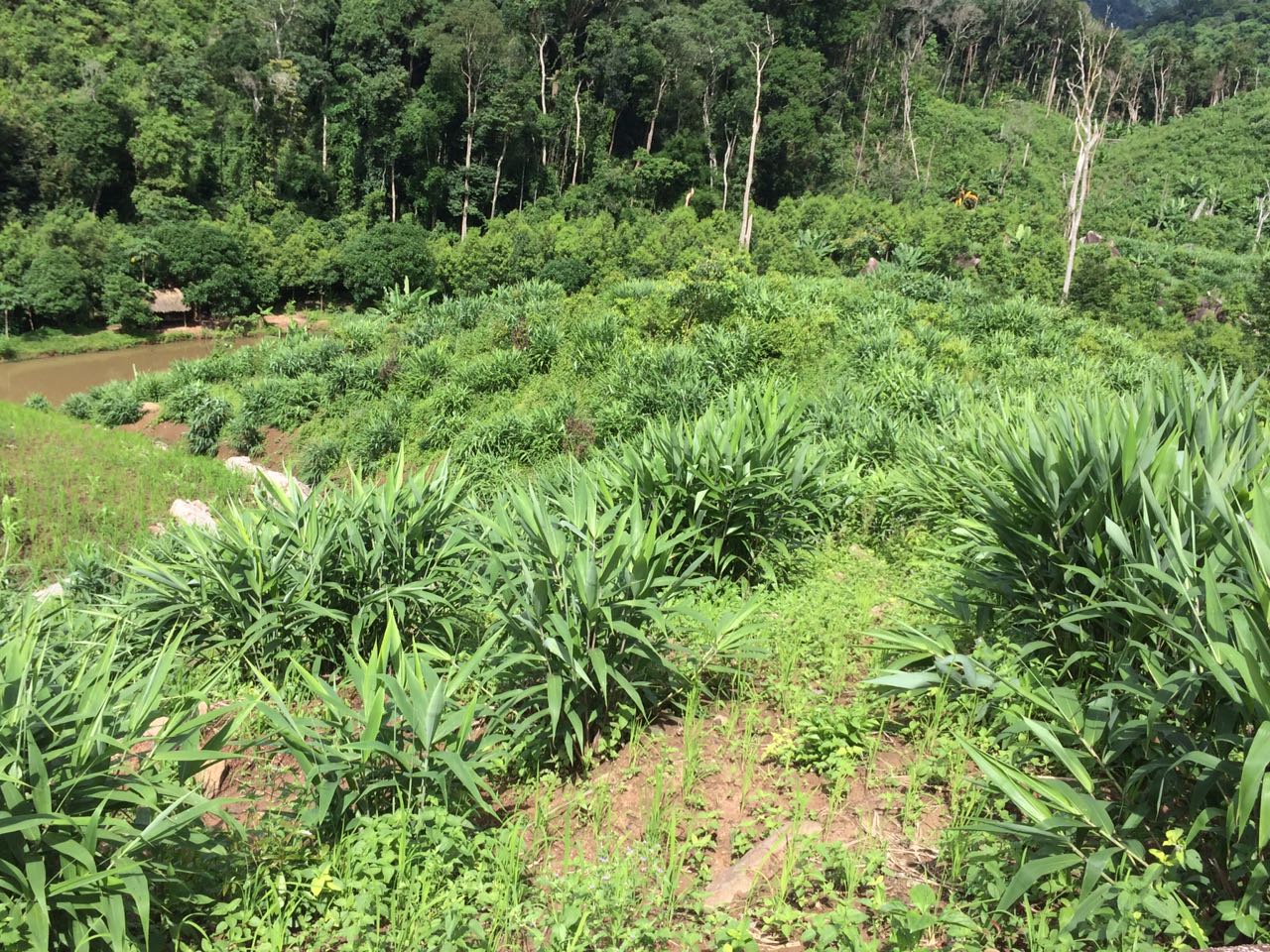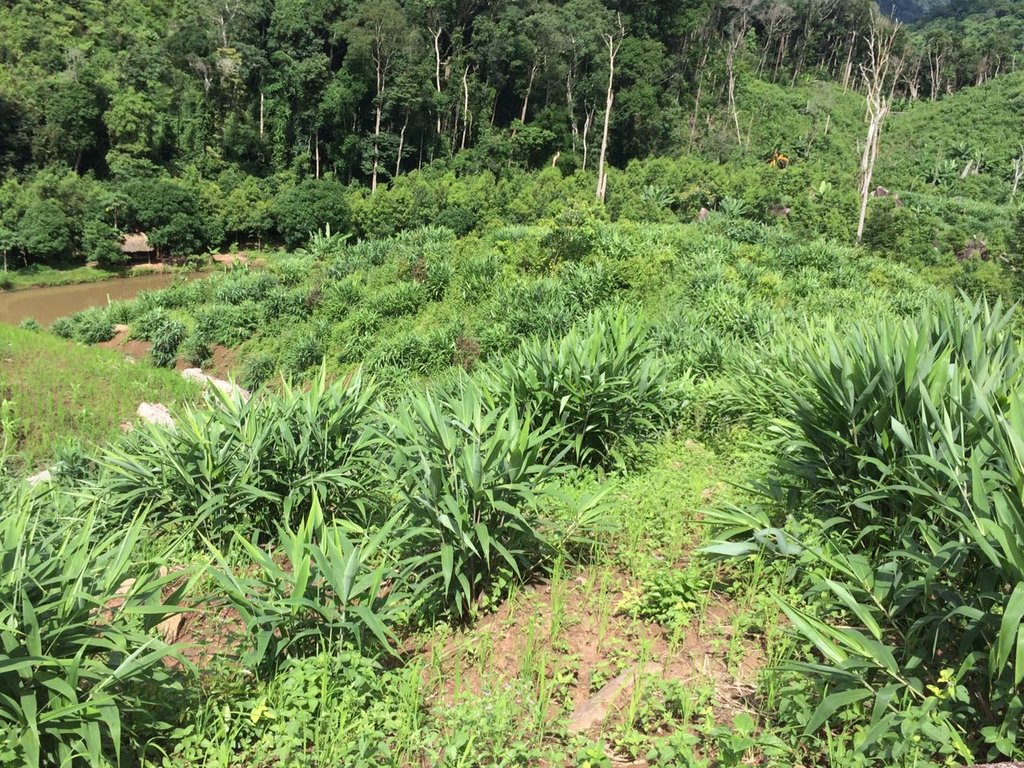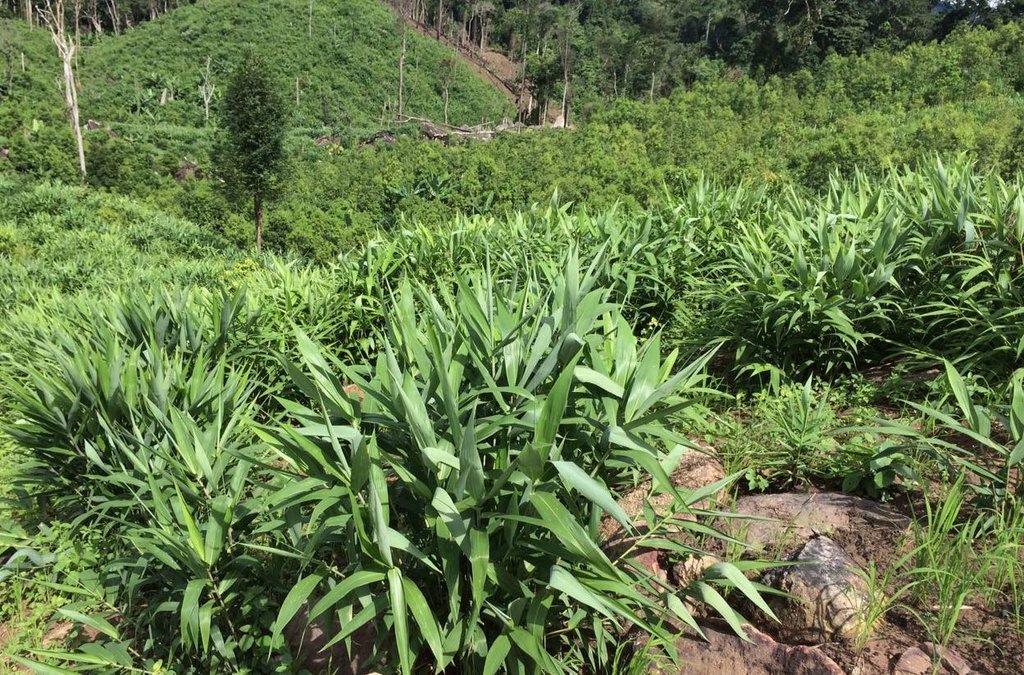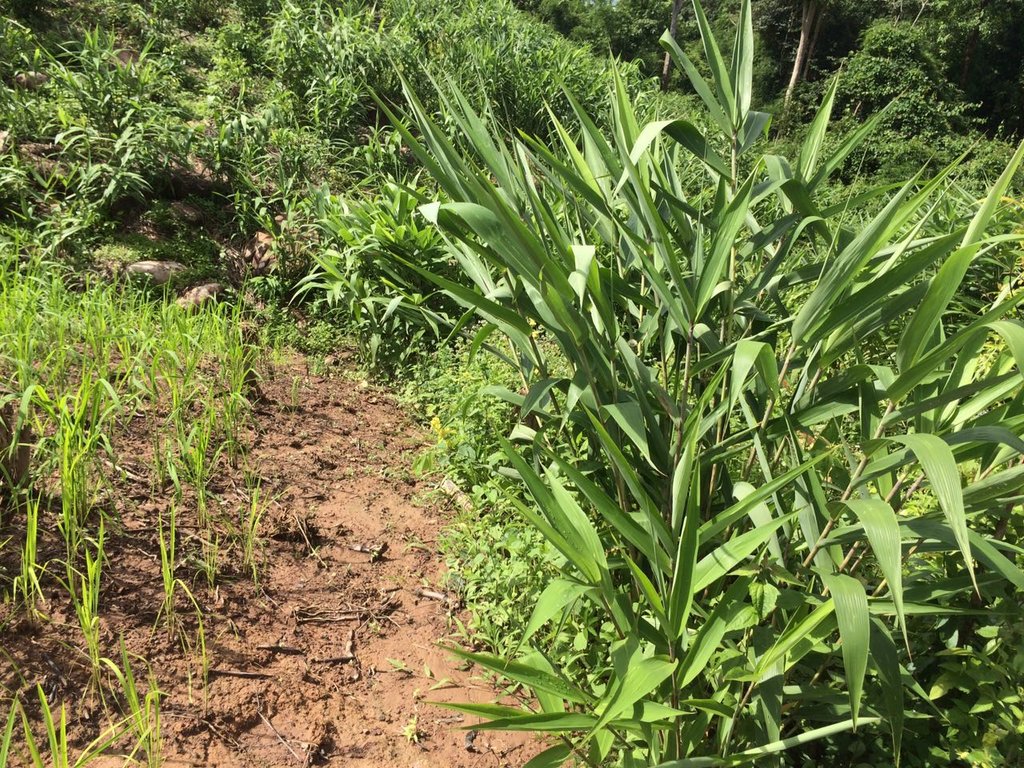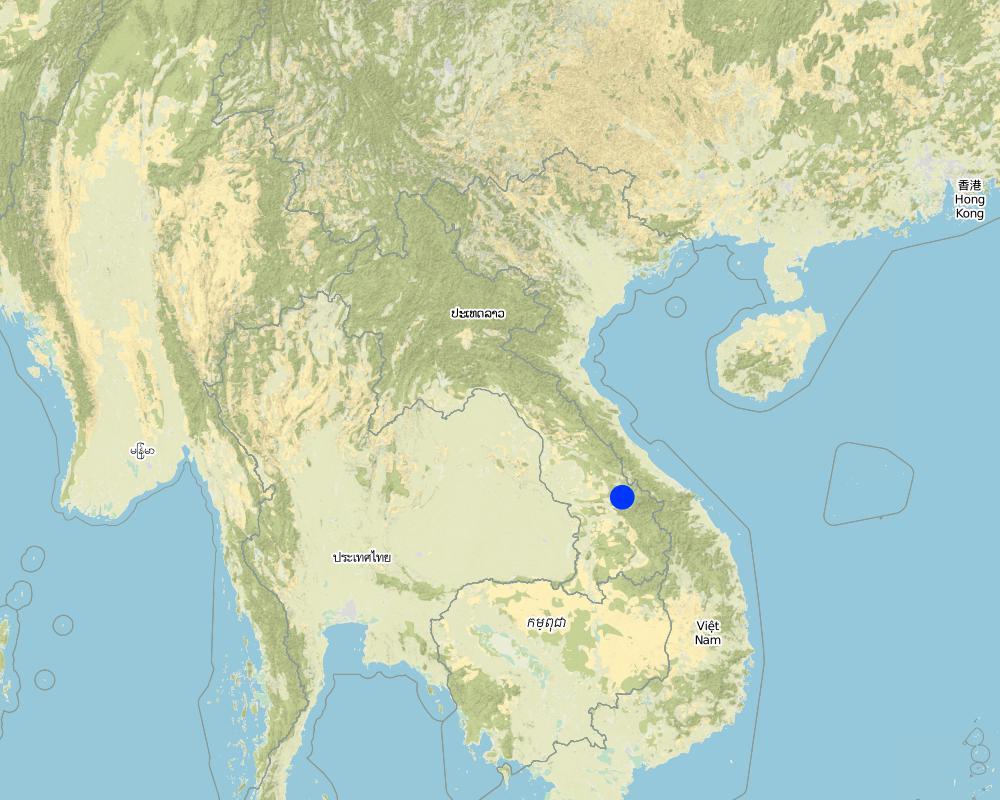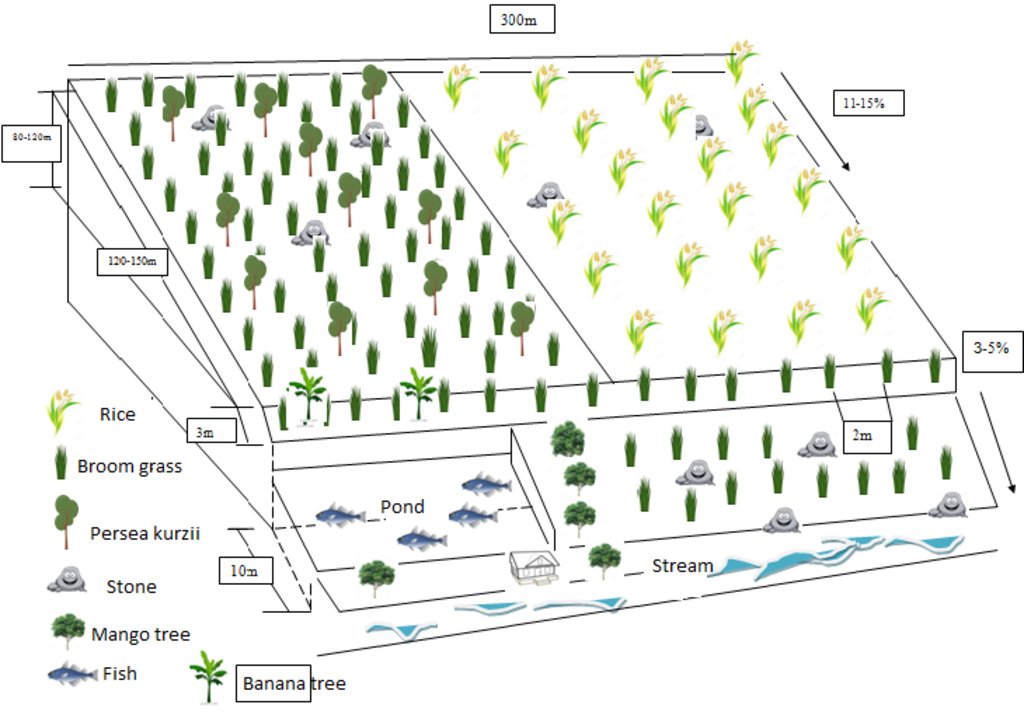ການປູກແຂມ ໃນເຂດພື້ນທີ່ຄ້ອຍຊັນ ເພື່ອປ້ອງກັນດີນເຊາະເຈື່ອນ [Lao People's Democratic Republic]
- Creation:
- Update:
- Compiler: kang phanvongsa
- Editors: Bounthanom Bouahom, Pasalath Khounsy, anousit namsena, kang phanvongsa, THEPPADITH MEUNPANTAVONG
- Reviewers: viengsavanh phimphachanhvongsod, Nicole Harari, Stephanie Jaquet, Alexandra Gavilano
ເຈາະຕັງຕາມຕະກື
technologies_2930 - Lao People's Democratic Republic
View sections
Expand all Collapse all1. معلومات عامة
1.2 Contact details of resource persons and institutions involved in the assessment and documentation of the Technology
land user:
ພອນໄຊ
Lao People's Democratic Republic
Name of project which facilitated the documentation/ evaluation of the Technology (if relevant)
Scaling-up SLM practices by smallholder farmers (IFAD)Name of the institution(s) which facilitated the documentation/ evaluation of the Technology (if relevant)
National Agriculture and Forestry Research Institute (NAFRI) - Lao People's Democratic Republic1.3 Conditions regarding the use of data documented through WOCAT
The compiler and key resource person(s) accept the conditions regarding the use of data documented through WOCAT:
نعم
1.4 Declaration on sustainability of the described Technology
Is the Technology described here problematic with regard to land degradation, so that it cannot be declared a sustainable land management technology?
لا
2. Description of the SLM Technology
2.1 Short description of the Technology
Definition of the Technology:
ເຕັກນິກ ການປູກແຂມ ຈຸດປະສົງ ເພື່ອປ້ອງກັນດິນເຈື່ອນ ຢູ່ເຂດເນີນພູ ແລະ ແຄມຫ້ວຍ ເຊີ່ງຕິດກັບພື້ນທີ່ ການຜະລິດກະສິກຳ. ເພາະວ່າ ລະບົບຮາກ ຂອງຕົ້ນແຂມ ມີຮາກຝອຍແຕກ ແຜ່ລາມອອກຫຼາຍ ຊື່ງສາມາດຍືດເກາະດິນໄດ້ເປັນຢ່າງດີ. ນອກຈາກນ້ີ, ແຂມຍັງສາມາດ ສ້າງລາຍຮັບ ໃຫ້ຊາວກະສິກອນໄດ້.
2.2 Detailed description of the Technology
Description:
ສະພາບ ການປ່ຽນແປງ ທາງດ້ານດິນຟ້າອາກາດ ໄດ້ສົ່ງຜົນກະທົບ ຕໍ່ລະບົບການຜະລິດ ແລະ ຊີວິດການເປັນ ຢູ່ຂອງປະຊາຊົນ ໃນທ້ອງຖິ່ນຊົນນະບົດ ເປັນຕົ້ນແມ່ນ ໃນເຂດຊົນນະບົດພູດອຍ. ຈາກບັນຫາການປ່ຽນແປງດິນຟ້າອາກາດ ເປັນຕົ້ນແມ່ນບັນຫາຝົນຕົກໜັກແກ່ຍາວ, ຝົນຕົກແຮງສ່ວນຫຼາຍແມ່ນ ເດືອນ 7-8 ແລະ ມັນສົ່ງຝົນເຮັດໃຫ້ດີນມີການເຊາະເຈື່ອນດ້ວຍນໍ້າຝົນຢູ່ໃນເຂດຄ້ອຍຊັນ. ສະນັ້ນຈ່ືງໄດ້ປູກແຂມ ເພ່ືອເຮັດໃຫ້ດິນມີຕວາາມທົນທານ ແລະ ປ້ອງກັນການເຊາະເຈ່ືອນຂອງດີນ, ດັ່ງນັ້ນ ໃນປິ 2011, ຊາວກະສິກອນ ຢູ່ບ້ານ ຈໍລະວຽງ ເມືອງ ຕະໂອ້ຍ ຈື່ງໄດ້ ທົດລອງເກັບເອົາເຫົ້ງາແຂມ ຕາມທຳມະຊາດ ເພື່ອມາປູກໃສ່ດິນໄຮ່ ທີ່ເປັນເຂດຄ້ອຍຊັນ ທີ່ໄດ້ຮັບຜົນກະທົບການດິນເຊາະເຈ່ືອນ.ຈຸດປະສົງຫຼັກ ຂອງຊາວກະສິກອນ ໃນການປູກແຊມ ແມ່ນ ປ້ອງກັນດິນເຈື້ອນ ເຊື່ງອາດຈະສົ່ງຜົນກະທົບ ຕໍ່ພືດພັນທັນຍາຫານ. ໃນເວລາດຽວກັນ ກໍ່ງ່າຍຕໍ່ການຈັດການ ແລະ ເກັບກ່ຽວດອກແຂມ ໃນພື້ນທີ່ ດິນຂອງຕົນເອງ, ເຊື່ງພໍ່ຄ້າ ຈະມາຊື້ເອົາຢູ່ຕາມບ້ານ. ສິ່ງສຳຄັນ, ຕົ້ນແຂມສາຍພັນພ້ືນເມືອງ ແມ່ນ ມີລະບົບຮາກ ແຜ່ຂະຫຍາຍ ລົງເລິກໃນດິນ ມີຄວາມຍາວປະມານ 1 – 2 ແມັດ, ສາມາດຈັບເກາະກັບດິນໄດ້ດີ. ຍິ່ງໄປກ່ວານັ້ນ ແຂມ ຍັງສາມາດ ປັບຕົວເຂົ້າກັບສະພາບແວດລ້ອມໄດ້ດີ, ທົນທານຕໍ່ພະຍາດໄດ້ ແລະ ສັດລ້ຽງກໍ່ບໍ່ກີນ (ຍ້ອນວ່າໃບຂອງແຂມ ມີລັກສະນະເປັນຂົນຊາໆເຮັດໃຫ້ສັດບໍ່ມັກ).ສຳລັບການກະກຽມອຸປະກອນ ໃນການໄປເອົາເຫົ້ງາແຂມມາປູກ ປະກອບມີ: ສຽມ, ພ້າ ແລະ ກະພາໃສ່ (ກະຕ່າໄມ້) ວິທີການເລືອກເກັບເອົາແຂມ ເພື່ອມາປູກ ແມ່ນຕ້ອງໄດ້ໄປເກັບເອົາແຂມ ທີ່ເກີດຢູ່ບ່ອນທີ່ຄ້ອຍຊັນ ແລະ ເກີດ ຢູ່ຕາມເປີ້ນພູ ແລະ ເທີງພູ (ສັນພູ) ເປັນສ່ວນຫຼາຍ ໂດຍຂຸດເອົາຕົ້ນແຂມ ພ້ອມທັງຮາກ, ຕັດກ້ານ ແລະ ໃບ ອອກ ໃຫ້ເຫຼືອປະມານ 30 cm. ການປູກແຂມໃນທີ່ນີ້ ແມ່ນ ປູກໃສ່ເນື້ອທີ່ດິນ ທີ່ມີຄວາມຍາວປະມານ 300 ແມັດ ແລະ ກວ້າງ ລະຫວ່າງ 80-120 ແມັດ ເທີງເຂດທີ່ມີຄວາມຊັນ ລະຫວ່າງ 11-15%. ເຫົ້ງາແຂມທີ່ແຂງແຮງ ທີ່ສາມາດເກັບເອົາຕາມເຂດປ່າໃນທ້ອງຖິ່ນ, ມາປູກໃນປະລິມານ 6000 ເຫົ້ງາ/ເຮັກຕາ.ໂດຍທົ່ວໄປ ແມ່ນ ປູກລະຫວ່າງເດືອນ 4-5 ເພາະໃນຊ່ວງນີ້ ອຸນະພາບໃນດິນຍັງມີຄວາມສົມດູນດີ. ໃນຊ່ວງນີ້ດິນ ແມ່ນ ຍັງມີຄວາມຮ້ອນເຮັດໃຫ້ຮາກພືດ ແລະ ແກ່ນພືດມີການກະຕຸ້ນໃນການແຕກງອກ ແລະ ຈະເລີນເຕີບໂຕໄວ, ຖ້າວ່າດິນຖືກຄວາມຊຸ່ມຫຼາຍ(ຝົນຕົກຫຼາຍວັນແລ້ວ ປະມານເດືອນ 6 ຂ້ືນໄປແລ້ວດິນຈະເຢັນ ເຮັດໃຫ້ເຮົາປູກບ່ໍໄດ້, ປູກກະບ່ໍງາມ ກ່ອນອ່ືນໝົດ ແມ່ນໄປຂຸດເອົາ ແຂມ ແລ້ວເອົາມາປະໄວ້ ບ່ອນຮົ່ມ1-2 ວັນ, ຫຼັງຈາກນັ້ນ ຂຸດຂຸມໃຫ້ເລີກ, ກວ້າງ 20 x 20 ຊັງຕີແມັດ, ເອົາຕົ້ນແຂມມາປູກ 4-5 ແໜ່ງ ຕໍ່ຂຸມ ໄລຍະຫ່າງຕົ້ນຕໍ່ຕົ້ນ 2 ແມັດ ແລະ ການປູກເລີ່ມປູກແຕ່ບ່ອນທີ່ ຕໍ່າຫາ ບ່ອນທີ່ສູງຂື້ນໄປ ຕາມແລວຕັດ ຂວາງຂອງພື້ນທີ ສວ່ນວ່າຕົ້ນໂບງ ແລະ ໄມ້ໃຫ້ໝາກທີ່ ປູກຊັບຫວ່າງນັ້ນ ປູກຕາມຫວ່າງຂອງແຖວທີ່ 2 ເລີຍ, ຫຼັງຈາກປູກແຂມໄດ້ປີທຳາອິດ 2011 ລາວໄດ້ນຳເອົາຕົ້ນໂບງໄປປູກ ຖັດຈາກແຖວທີ 2 ຂອງແຂມຕໍ່ໄປ ເພາະວ່າແຂມຍັງໄດ້ເກາະດິນໄວ້ ແລະ ຫວ່າງຂອງແຂມ ແມ່ນ ຍັງມີຄວາມຊຸ່ມຂອງນໍ້າ ເຮັດໃຫ້ຕົ້ນໂບງມີການຈະເລີນເຕີບໂຕໄວ.ພາຍຫຼັງຈາກປູກແຂມແລ້ວ ຕ້ອງມີໄດ້ດູແລຮັກສາຢ່າງໜ້ອຍ ປີລະ 1 ຄັ້ງ (ໃນປີທີ 2 ຫາ 3 ກໍ່ສາມາດເກັບດອກແຂມໄດ້) ໂດຍການເສຍຫຍ້າ, ສ່າງລຳທີ່ຕ່າຍອອກ ແລ້ວເອົາຫຍ້າ ແລະ ລຳຕາຍທີ່ເຮົາສາ່ງອອກ ມາປົກໄວ້ອ້ອມໆເຫົ້ງາ ແລະ ຮາກຂອງ ຕົ້ນແຂມ ເພາະວ່າຫຍ້າ ແລະ ໃບຂອງມັນ ຍັງສາມາດເປັນຝຸ່ນ, ຫຸຼດຜ່ອນການໄຫຼເຊາະຂອງນຳ້ ແລະ ຍັງຮັກສາຄວາມຊຸ່ມຂອງດີນ. ພໍຮອດຊ່ວງລະດູຝົນຕົກ (ເດືອນ 6-10) ຮາກ ແລະ ແໜ່ງຂອງ ຕົ້ນແຂມ ແມ່ນສາມາດແຕກແໜງດີ ແລະ ຍັງຄຸມໜ້າດິນ ເພ່ືອບ່ໍໃຫ້ດິນເຊາະເຈ່ືອນຈາກນ້ຳຝົນໄດ້. ຜົນດີ ຂອງເຕັກນິກການປູກແຂມ ແມ່ນເພ່ືອປ້ອງກັນການເຊາະເຈ່ືອນຂອງດິນ ແລະ ດອກແຂມຍັງໄດ້ສ້າງລາຍຮັບໃຫ້ແກ່ຄອບຄົວ ເນື່ອງຈາກຕະຫຼາດມີຄວາມຕ້ອງການຫຼາຍ ເນື້ອທີ່ ປູກແຂມ 1.5 ເຮັກຕາ ມີລາຍຮັບຈາກການຂາຍດອກແຂມ ເປັນເງີນ 2,000,000 ກີບ/ໂຕນ. ປະຈຸບັນແຂມ ສາມາດນຳໄຊ້ເຂົ້າໃນການຈັກ ສານເຊັ່ນ: ເຮັດຟອຍ, ເຄື່ອງຈັກສານອື່ນໆ ຂາຍພາຍໃນ ແລະ ສົ່ງອອກປະເທດໃກ້ຕຽງ. ປະຈຸບັນ, ກໍ່ໄດ້ມີຫຼາຍຄອບຄົວ ທີ່ພາກັນປູກແຂມເພ່ືອເປັນສິນຄ້າ ແລະ ສາມາດຫຸຼດຜ່ອນບັນ ຫາການຍາດແຍ່ງແຂມທຳມະຊາດ ທີ່ເກີດຢູ່ຕາມພູຕາມຜາ ເພາະປະຊາຊົນສາມາດປູກໃສ່ພື້ນທີ່ດິນຂອງ ເຂົາເຈົ້າເອງ.
2.3 Photos of the Technology
2.5 Country/ region/ locations where the Technology has been applied and which are covered by this assessment
بلد:
Lao People's Democratic Republic
Region/ State/ Province:
ເມືອງ ຕະໂອ້ຍ ແຂວງ ສາລະວັນ
Further specification of location:
ບ້ານ ຈໍລະວຽງ
Specify the spread of the Technology:
- evenly spread over an area
If precise area is not known, indicate approximate area covered:
- < 0.1 km2 (10 ha)
Map
×2.6 Date of implementation
Indicate year of implementation:
2011
If precise year is not known, indicate approximate date:
- less than 10 years ago (recently)
2.7 Introduction of the Technology
Specify how the Technology was introduced:
- through land users' innovation
3. Classification of the SLM Technology
3.1 Main purpose(s) of the Technology
- reduce, prevent, restore land degradation
- conserve ecosystem
- reduce risk of disasters
- create beneficial economic impact
- create beneficial social impact
3.2 Current land use type(s) where the Technology is applied

الأراضي الزراعية
- Perennial (non-woody) cropping
Number of growing seasons per year:
- 1
Comments:
ການປູກພືດຫຼັກ (ທີ່ສາມາດສ້າງລັບຮັບ ເປັນເງິນສົດ ແລະ ເປັນພືດສະບຽງອາຫານ): ແຂມ ແລະ ຢາງບົງ
3.4 Water supply
Water supply for the land on which the Technology is applied:
- rainfed
3.5 SLM group to which the Technology belongs
- rotational systems (crop rotation, fallows, shifting cultivation)
- improved ground/ vegetation cover
3.6 SLM measures comprising the Technology

agronomic measures
- A1: Vegetation/ soil cover

vegetative measures
- V2: Grasses and perennial herbaceous plants

management measures
- M5: Control/ change of species composition
3.7 Main types of land degradation addressed by the Technology

soil erosion by water
- Wt: loss of topsoil/ surface erosion
- Wg: gully erosion/ gullying
- Wr: riverbank erosion
- Wo: offsite degradation effects
3.8 Prevention, reduction, or restoration of land degradation
Specify the goal of the Technology with regard to land degradation:
- prevent land degradation
- reduce land degradation
4. Technical specifications, implementation activities, inputs, and costs
4.1 Technical drawing of the Technology
Technical specifications (related to technical drawing):
- ພື້ນທີ່ມີຄວາມຍາວ 300 m, ກວ້າງ 80 m - 120 mຊ່ອງຫວ່າງລະຫວ່າງພືດແມ່ນ 2 x 2 ມ, 4-5 ຮູຂຸມຂົນຕໍ່ພືດ.- ມຸມຊ້ນ 11-15%, ສໍາລັບຕີນພູແມ່ນ 3-5%.ພື້ນທີ່ ທີ່ໄດ້ຮັບການປ້ອງກັນ (ເຂດພື້ນທີ່ປ້ອງກັນຢູ່ຕາມຕີນພູລຽບຕາມພື້ນທີ່ການປູກຝັງແມ່ນ 3 m)- ອຸປະກອນ: ມີດ, ຂີ້ດ, ກະຕ່າ ສໍາລັບການເກັບເຫົ້ງາແຂມ- ແຂມ ແມ່ນຖືກນໍາມາຈາກທໍາມະຊາດ ໂດຍການຕັດເອົາເຫົ້ງາລວມທັງລໍາຕົ້ນ.- ຄວາມຫນາແຫນ້ນຂອງແຂມ ແມ່ນ 6000 ເຫົ້ງາຕໍ່ເຮັກຕາ ຊະນິດພັນຕົ້ນແຂມທໍາມະຊາດສາມາດປູກໃນເກືອບທຸກຊະນິດຂອງດິນ. ຊະນິດນີ້ມີໃບຍາວ (60-80 ຊມ) ສາມາດເປັນຮົ່ມບັງແສງແດດ ທີ່ສ່ອງໂດຍກົງເຂົ້າໄປໃນດິນ, ແລະ ກ້ານແຂມສາມາດຍາວໄດ້ເຖິງ 1.5-2 ແມັດ. ຫນື່ງສູມຂອງແຂມຈະມີລະຫວ່າງ 10-20 ກ້ານ. ທີ່ດິນທີ່ໄດ້ນໍາໃຊ້ປູກຝັງ ແບບເລື່ອນລອຍໃນເມື່ອກ່ອນ ດຽວນີ້ ແມ່ນ ປູກແຂມປົນກັບຕົ້ນຢາງບົງ, ໃນປັດຈຸບັນມີເນື້ອທີ່ ປູກເຂົ້າໄຮ່ ຢູ່ໃກ້ກັບແຂມ ແລະ ຕົ້ນຢາງບົງ, ທໍາອິດຫຼັງຈາກປູກແຂມ, ຫຼັງຈາກນັ້ນ ກໍ່ປູກຢາງບົງ ຫມູນວຽນ ກັບ ເຂົ້າໄຮ່ ໃນພື້ນທີ່ກ່ອນຫນ້ານີ້ທີ່ມີການປູກຢາງບົງ . ຕົວຈິງແລ້ວ, ໃນຮູບແບບນີ້, ຊາວກະສິກອນມີສອງເນື້ອທີ່- ຫນື່ງດິນໄດ້ຖືກປູກມາຕັ້ງແຕ່ປີ 2011ເຊິ່ງປະກອບດ້ວຍຕົ້ນແຂມ ແລະ ຢາງບົງ, ໃນຂະນະທີ່ ດິນຕອນອື່ນມີແຊມເທົ່ານັ້ນ ນັບຕັ້ງແຕ່ປີ 2012 ແລະ ຫຼັງຈາກປູກຕົ້ນຢາງ ໃນປີ 2015. ນອກຈາກນັ້ນ, ຕົ້ນໄມ້ຫມາກໄມ້ ແລະ ໜອງປາຢູ່ທາງລຸ່ມຂອງເນື້ທີ່ປູກແຂມ. ນີ້ ແມ່ນ ຍ້ອນວ່າພືດທີ່ເຕີບໂຕໜາແໜ້ນ ຊ່ວຍປ້ອງກັນບໍ່ໃຫ້ຕະກອນດິນໄຫຼລົງໜອງປາ. ກ່ອນຫນ້ານີ້ພື້ນທີ່ນີ້ ໄດ້ນໍາໃຊ້ເຂົ້າໃນການຜະລິດເຂົ້າ, ຢາງບົງ ແລະ ຕົ້ນຫມາກໄມ້ອື່ນໆ, ຫຼັງຈາກການເກັບກ່ຽວເຂົ້າ ແລະ ຕັດດອກແຂມ, ກ່ອນທີ່ຈະປູກເຂົ້າໄຮ່ອີກຄັ້ງ ແລະມັນຖືກລ້ອມຮອບດ້ວຍຫີນໃຫຍ່ ແລະ ນ້ອຍ.
Author:
ພອນສີລິ ພັນວົງສາ
Date:
11/07/2017
4.2 General information regarding the calculation of inputs and costs
Specify how costs and inputs were calculated:
- per Technology area
Indicate size and area unit:
ເນື້ອທີ 3 ເຮັກຕາ
If using a local area unit, indicate conversion factor to one hectare (e.g. 1 ha = 2.47 acres): 1 ha =:
ຍາວ 300 ແມັດ , ກວ້າງ 100 ແມັດ
other/ national currency (specify):
ກີບ
If relevant, indicate exchange rate from USD to local currency (e.g. 1 USD = 79.9 Brazilian Real): 1 USD =:
8400,0
Indicate average wage cost of hired labour per day:
50,000
4.3 Establishment activities
| Activity | Timing (season) | |
|---|---|---|
| 1. | ຖ່າງຫຍ້າ | 30 ວັນ ກອ່ນ ລະດູຝົນ |
| 2. | ຊອກຫາແນວພັນຕາມທຳມະຊາດ | |
| 3. | ຂຸດຂຸມ ແລະ ປູກ |
4.4 Costs and inputs needed for establishment
| Specify input | Unit | Quantity | Costs per Unit | Total costs per input | % of costs borne by land users | |
|---|---|---|---|---|---|---|
| Labour | ແຮງານ | ຄົນ/ມື້ | 3,0 | 50000,0 | 150000,0 | 100,0 |
| Labour | ແຮງງານເກັບເຫົ້ງາແຂມ | ຄົນ/ມື້ | 3,0 | 50000,0 | 150000,0 | 100,0 |
| Labour | ແຮງງານຂຸດຂຸມ ແລະ ປູກ | ຄົນ/ມື້ | 3,0 | 50000,0 | 150000,0 | 100,0 |
| Equipment | ສຽມ | ດວງ | 4,0 | 15000,0 | 60000,0 | 100,0 |
| Equipment | ພ້າເສຍຫຍ້າ | ດວງ | 4,0 | 25000,0 | 100000,0 | 100,0 |
| Equipment | ກະພາ | ອັນ | 4,0 | 50000,0 | 200000,0 | 100,0 |
| Total costs for establishment of the Technology | 810000,0 | |||||
| Total costs for establishment of the Technology in USD | 96,43 | |||||
4.5 Maintenance/ recurrent activities
| Activity | Timing/ frequency | |
|---|---|---|
| 1. | ເສຍຫຍ້າ | ປີລະເທື່ອ |
| 2. | ສ່າງໃນທີ່ຕາຍອອກ | ປີລະເທື່ອ |
4.6 Costs and inputs needed for maintenance/ recurrent activities (per year)
| Specify input | Unit | Quantity | Costs per Unit | Total costs per input | % of costs borne by land users | |
|---|---|---|---|---|---|---|
| Labour | ແຮງງານເສຍຫຍ້າ, ສ່າງໃບ | ຄົນ/ມື້ | 4,0 | 50000,0 | 200000,0 | 100,0 |
| Total costs for maintenance of the Technology | 200000,0 | |||||
| Total costs for maintenance of the Technology in USD | 23,81 | |||||
4.7 Most important factors affecting the costs
Describe the most determinate factors affecting the costs:
ແຮງງານ ໃນການໄປຊອກຂຸດເຫງົ້າແຂມມາປູກ
5. Natural and human environment
5.1 Climate
Annual rainfall
- < 250 mm
- 251-500 mm
- 501-750 mm
- 751-1,000 mm
- 1,001-1,500 mm
- 1,501-2,000 mm
- 2,001-3,000 mm
- 3,001-4,000 mm
- > 4,000 mm
Specify average annual rainfall (if known), in mm:
450,00
Specifications/ comments on rainfall:
ຊ່ວງຝົນຕົກໜັກແມ່ນຊ່ວງໄລຍະ ເດືອນ 6-7 ຂອງທຸກປີ ແກ່ຍາວເຖີງຕົ້ນເດືອນ 8
Indicate the name of the reference meteorological station considered:
ສູນບໍໍລິການເຕັກນິກກະສິກຳ ແລະ ປ່າໄມ້ ບ້ານດູບ ເມືອງຕະໂອ້ຍ ແຂວງສາລະວັນ
Agro-climatic zone
- humid
5.2 Topography
Slopes on average:
- flat (0-2%)
- gentle (3-5%)
- moderate (6-10%)
- rolling (11-15%)
- hilly (16-30%)
- steep (31-60%)
- very steep (>60%)
Landforms:
- plateau/plains
- ridges
- mountain slopes
- hill slopes
- footslopes
- valley floors
Altitudinal zone:
- 0-100 m a.s.l.
- 101-500 m a.s.l.
- 501-1,000 m a.s.l.
- 1,001-1,500 m a.s.l.
- 1,501-2,000 m a.s.l.
- 2,001-2,500 m a.s.l.
- 2,501-3,000 m a.s.l.
- 3,001-4,000 m a.s.l.
- > 4,000 m a.s.l.
Indicate if the Technology is specifically applied in:
- convex situations
5.3 Soils
Soil depth on average:
- very shallow (0-20 cm)
- shallow (21-50 cm)
- moderately deep (51-80 cm)
- deep (81-120 cm)
- very deep (> 120 cm)
Soil texture (topsoil):
- fine/ heavy (clay)
Soil texture (> 20 cm below surface):
- fine/ heavy (clay)
Topsoil organic matter:
- medium (1-3%)
5.4 Water availability and quality
Ground water table:
5-50 m
Availability of surface water:
good
Water quality (untreated):
for agricultural use only (irrigation)
Is water salinity a problem?
لا
Is flooding of the area occurring?
لا
5.5 Biodiversity
Species diversity:
- medium
Habitat diversity:
- medium
5.6 Characteristics of land users applying the Technology
Sedentary or nomadic:
- Sedentary
Market orientation of production system:
- commercial/ market
Off-farm income:
- less than 10% of all income
Relative level of wealth:
- average
Individuals or groups:
- individual/ household
Level of mechanization:
- mechanized/ motorized
Gender:
- women
- men
Age of land users:
- youth
- middle-aged
5.7 Average area of land used by land users applying the Technology
- < 0.5 ha
- 0.5-1 ha
- 1-2 ha
- 2-5 ha
- 5-15 ha
- 15-50 ha
- 50-100 ha
- 100-500 ha
- 500-1,000 ha
- 1,000-10,000 ha
- > 10,000 ha
Is this considered small-, medium- or large-scale (referring to local context)?
- large-scale
5.8 Land ownership, land use rights, and water use rights
Land ownership:
- individual, titled
Land use rights:
- individual
Water use rights:
- open access (unorganized)
- individual
5.9 Access to services and infrastructure
health:
- poor
- moderate
- good
education:
- poor
- moderate
- good
technical assistance:
- poor
- moderate
- good
employment (e.g. off-farm):
- poor
- moderate
- good
markets:
- poor
- moderate
- good
energy:
- poor
- moderate
- good
roads and transport:
- poor
- moderate
- good
drinking water and sanitation:
- poor
- moderate
- good
financial services:
- poor
- moderate
- good
6. Impacts and concluding statements
6.1 On-site impacts the Technology has shown
Socio-economic impacts
Production
crop production
Comments/ specify:
ການເພີ່ມຂື້ນຂອງການປູກພືດເຊັ່ນ: ການປູກເຂົ້າໄຮ່ເພາະວ່າແຂມສາມາດປ້ອງກັນ ເຂົ້າຈາກຄວາມເສຍຫາຍຈາກພາຍຸຝົນ, ເຮັດໃຫ້ຜົນຜະລິດເຂົ້າດີຂື້ນ.
Income and costs
farm income
Comments/ specify:
ກ່ອນຫນ້ານີ້: ລາຍໄດ້ຕ່ໍາທີ່ສຸດຈາກການລເກັບດອກແຂມໃນປ່າທໍາມະຊາດ. ຫຼັງຈາກການປູກແຂມ: ຊາວກະສິກອນໄດ້ຮັບປະມານ 2,000,000 ກີບຕໍ່ໂຕນ
diversity of income sources
Comments/ specify:
ກ່ອນຫນ້ານີ້: ລະດັບຜະລິດຕະພັນທີ່ ຈະຂາຍໃນຕະຫຼາດແມ່ນຂະຫນາດນ້ອຍ, ບໍ່ຮັບປະກັນ ແລະ ປະລິມານກໍ່ຕ່ໍາ (ລາຍໄດ້ເລັກນ້ອຍຈາກກ້ວຍ, ເຂົ້າ, ຫມາກນັດ). ຫຼັງຈາກການປູກແຂມ: ລາຍໄດ້ເພີ່ມເຕີມ ແລະເປັນລາຍໄດ້ຫຼັກ ແລະ ເນ່ືອງຈາກວ່າມັນຍັງປ້ອງກັນຫນອງປາຢູ່ລຸ່ມເຂດຕີນພູ ເຊື່ງສາມາດເປັນແຫຼ່ງລາຍຮັບເພີ່ມເຕີມ
workload
Comments/ specify:
ກ່ອນຫນ້ານີ້, ແມ່ນໃຊ້ເວລາຫຼາຍໆມ້ື ເພ່ືອເກັບກ່ຽວດອກແຂມຈາກປ່າທໍາມະຊາດ, ຍ້ອນວ່າມັນຢູ່ໄກຈາກບ້ານ. ຫຼັງຈາກການປູກແຂມ: ມັນງ່າຍທີ່ ຈະເກັບດອກແຂມ (ການບໍາລຸງຮັກສາແມ່ນບ່ໍໄດ້ໃຊ້ແຮງງານຫຼາຍເມ່ືອທຽບກັບສະຖານະການກ່ອນ).
Ecological impacts
Soil
soil accumulation
Comments/ specify:
ໃນເມື່ອກ່ອນ: ໂດຍບໍ່ມີອຸປະສັກ ແລະ ສີ່ງປົກຄຸມດິນເຮັດໃຫ້ດິນ ທີ່ຖືກທໍາລາຍໂດຍກົງຈາກາກການໄຫຼເຊາະ ຂອງນ້ໍາ. ຫຼັງຈາກ: ການໄຫຼລົງຂອງນ້ຳຝົນ ຢ່າງຮຸນແຮງຖືກຂັດຂວາງໂດຍການປົກຫຸ້ມຂອງດິນ ເຊື່ງສາມາດຮັກສາດິນ. ນອກຈາກນັ້ນ, ເສດຊາກຂອງພືດຍັງສະໜອງ ອuນຊີວັດຖຸ ສໍາລັບການກາຍສະພາບເປັນດິນອີກ.
nutrient cycling/ recharge
Comments/ specify:
ຫຼັງຈາກການປູກແຂມ, ເສດຊາກພືດໄດ້ເພີ່ມຂ້ືນ ເຊິ່ງຊ່ວຍປັບປຸງສະພາບ ສານອາຫານຂອງດິນ
ແລະສ້າງອາຫານໃນດິນ ແລະ ສິ່ງມີຊີວິດຂະໜາດນ້ອຍ.
Climate and disaster risk reduction
landslides/ debris flows
Comments/ specify:
ການປົກຫຸ້ມ ຢ່າງຫນາແຫນ້ນ ແລະ ຂະຫຍາຍຕົວຂອງຕົ້ນແຂມ ທີ່ມີຮາກເລິກສາມາດ ຫຸຼດຜ່ອນການລະລ້າງ ແລະ ດິນເຈ່ືອນ.
6.2 Off-site impacts the Technology has shown
downstream siltation
Comments/ specify:
ຄວາມຫນາແຫນ້ນຂອງຕົ້ນ ແຂມ ແມ່ນ ມີບົດບາດສໍາຄັນ ໃນການເປັນຕົວກອງທີ່ ຈະຫຸຼດຜ່ອນການສະສົມຈະກອນດິນ ລູມຫ້ວຍ
6.3 Exposure and sensitivity of the Technology to gradual climate change and climate-related extremes/ disasters (as perceived by land users)
Gradual climate change
Gradual climate change
| Season | increase or decrease | How does the Technology cope with it? | |
|---|---|---|---|
| seasonal rainfall | wet/ rainy season | increase | very well |
6.4 Cost-benefit analysis
How do the benefits compare with the establishment costs (from land users’ perspective)?
Short-term returns:
slightly negative
Long-term returns:
very positive
How do the benefits compare with the maintenance/ recurrent costs (from land users' perspective)?
Short-term returns:
neutral/ balanced
Long-term returns:
neutral/ balanced
6.5 Adoption of the Technology
- 11-50%
Of all those who have adopted the Technology, how many did so spontaneously, i.e. without receiving any material incentives/ payments?
- 91-100%
6.6 التكيف
Has the Technology been modified recently to adapt to changing conditions?
لا
6.7 Strengths/ advantages/ opportunities of the Technology
| Strengths/ advantages/ opportunities in the land user’s view |
|---|
| ຮາກຂອງແຂມຢັ່ງລົງເລິກ, ເກາະດິນໄດ້ດີ ສາມາດປ້ອງກັນດີນເຊາະເຈ່ືອນ |
| ສາມາດນໍາໃຊ້ດິນ ໃນພື້ນທີ່ປູກພືດຫຼາຍຊະນີດ ສັບຫວ່າງ ກັບຕົ້ນແຂມ |
| ສາມາດສ້າງລາຍຮັບໃຫ້ແກ່ຄອບຄົວ ຈາກການຂາຍແຂມ |
| Strengths/ advantages/ opportunities in the compiler’s or other key resource person’s view |
|---|
| ປູກແຂມ ສາມາດປ້ອງກັນການເຊາະເຈ່ືອນຂອງດິນ ຈາກການຊະລ້າງຂອງນໍ້າຝົນ |
|
ສາມາດເກັບກັກທາດອາຫານ ແລະ ຊີວະມວນ ເທິງໜ້າດິນ ຊື່ງມັນຈະກາຍເປັນສານອິນຊີ ທີ່ ມີປະໂຫຍດ ຕໍ່ພືທີ່ປູກ |
6.8 Weaknesses/ disadvantages/ risks of the Technology and ways of overcoming them
| Weaknesses/ disadvantages/ risks in the land user’s view | How can they be overcome? |
|---|---|
| ຮາກຂອງຕົ້ນແຂມ ມີການຂະຫຍາຍຕົວ ແລະ ແຜ່ກວ້າງຢ່າງໄວວາຊື່ງສາມາດກວມເອົາພື້ນທີ່ ທີ່ທໍາການຜະລິດ ເຮັດໃຫ້ພື້ນທີ່ ການປູກພືດຊະນິດອ່ືນຈໍາກັດ | ໃຫ້ມີການຈັດການແບ່ງເຫງົ້້າແຂມ ໂດຍການຕັດ ແລະ ສອຍ ຮາກຂອງຕົ້ນແຂມອອກ ເພ່ືອບ່ໍໃຫ້ແຜ່ລາມກວ້າງອອກໄປ |
| ຕົ້ນແຂມ ຢູ່ເທິງພື້ນທີ່ຄ້ອຍຊັນ ອາດເຮັດໃຫ້ມັນຍາກທີ່ຈະຮັກສາ ແລະ ເກັບກ່ຽວຜົນຜະລິດ. |
7. References and links
7.1 Methods/ sources of information
- field visits, field surveys
1 ຄັ້ງ
- interviews with land users
ຜູ້ໃຫ້ສະພາດ 2 ຄົນ
When were the data compiled (in the field)?
11/07/2017
Links and modules
Expand all Collapse allLinks
No links
Modules
No modules


